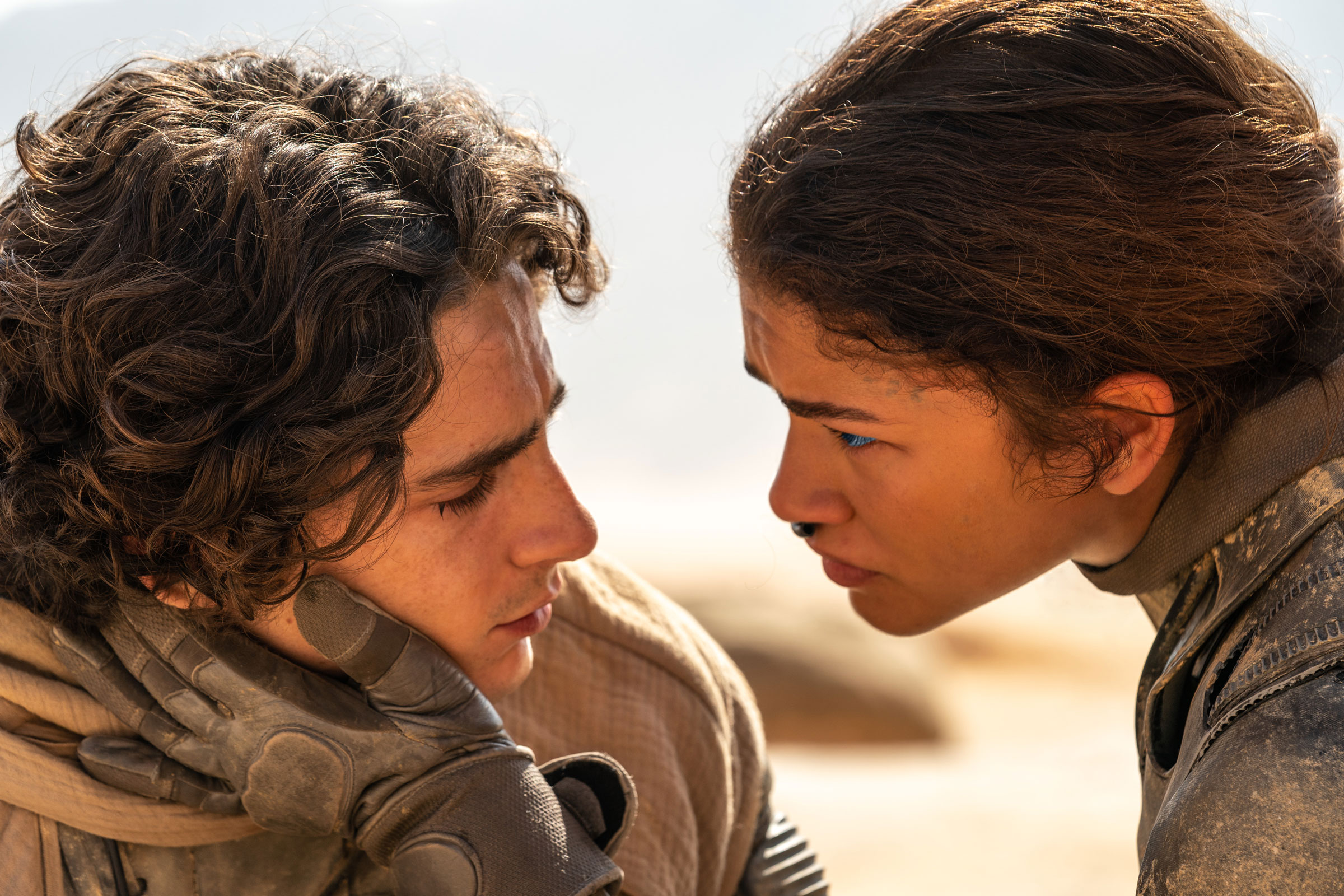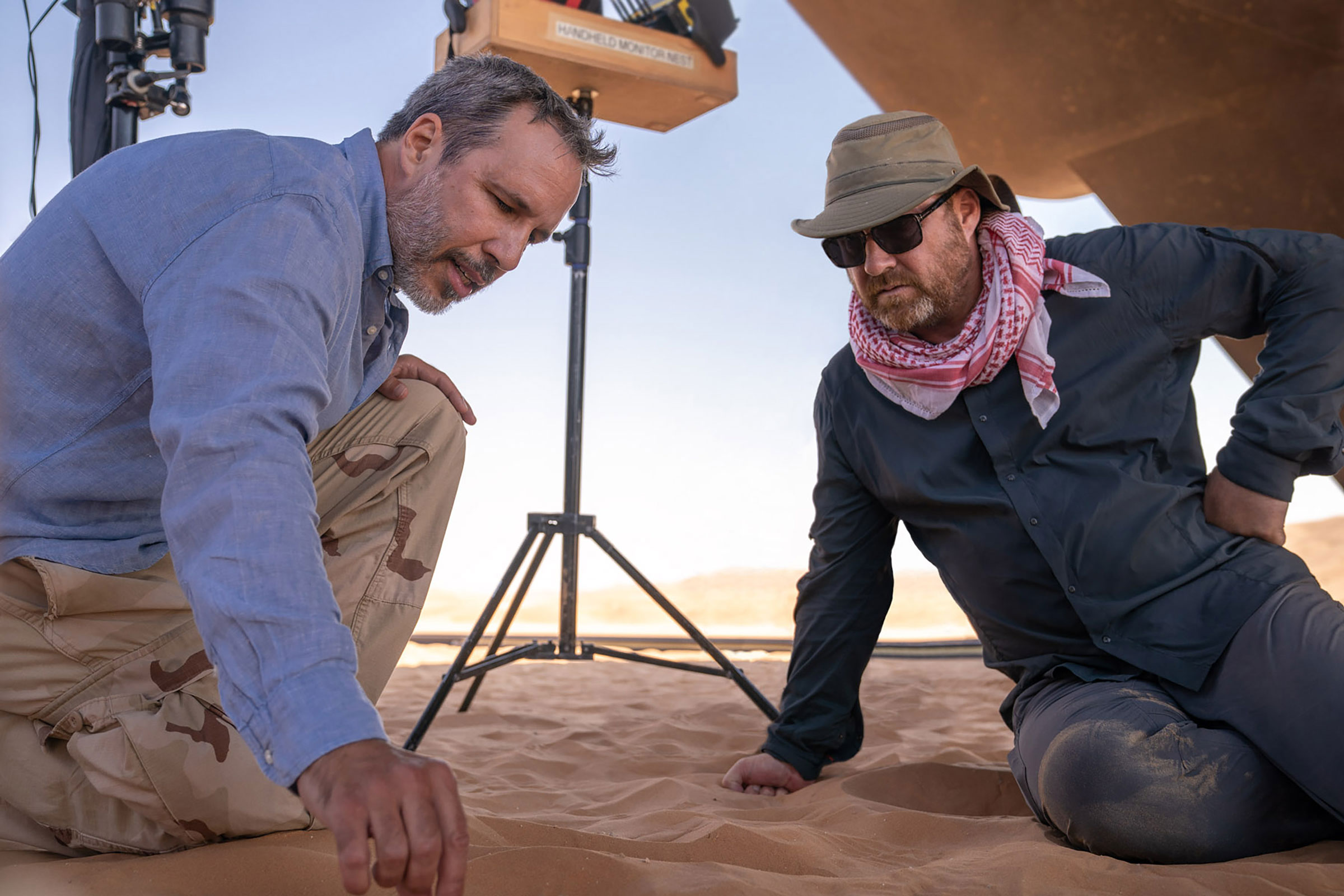For Denis Villeneuve, adapting any book—let alone one that’s been adored by readers since 1965—is an act of treason. “When you adapt, you kill. You destroy in the process of transformation. Going from the words to the image, this adaptation is my adaptation, with my sensibility.”
The book in question is Dune, Frank Herbert’s futuristic midcentury novel about—among many other things—a young nobleman named Paul Atreides, who learns to live among a society of desert dwellers known as the Fremen, and who may even be their messiah. The first part of Villeneuve’s two-movie epic, Dune, was released in 2021. The second, Dune: Part Two, arriving on March 1, marks the end of a kind of Arthurian quest for Villeneuve, now 56, who has loved the novel since he first read it at age 14. And even though he has interpreted Herbert’s work in his own fashion—which is where the treason comes in—preserving the book’s spirit was paramount. “I was trying to be, as a filmmaker, as invisible as possible. I tried my best to keep the poetry of the book, the atmosphere, the colors, the smell, everything that I felt when I read the book. I tried.”
Villeneuve, speaking via Zoom from the countryside north of Montreal, is currently working on three screenplays, including a Dune sequel, even as he recuperates from this project that has consumed six years of his life. It’s a period of regeneration with no time for any real rest. Villeneuve is one of a small group of serious mainstream filmmakers—Christopher Nolan and Quentin Tarantino are two others—who, as roughly middle-aged veterans, believe wholeheartedly in the grand-scale experience. Other directors have succumbed to the false allure of franchise filmmaking, hoping to put a stamp of individuality on this or that Star Wars or Marvel film. But Villeneuve—whose superb 2010 breakthrough, Incendies, launched a streak of acclaimed pictures including Sicario (2015), Arrival (2016), and Blade Runner 2049 (2017)—remains committed to old-school big-screen filmmaking principles, making thoughtful, visually inventive movies that don’t hew to any prescribed canon. In an era when many filmmakers have had to resign themselves to working small, Villeneuve refuses to let the industry shrink him down to size.

The opening of Dune: Part Two is just a springboard leap from the ending of the first installment. After the armies launched by Baron Vladimir Harkonnen (Stellan Skarsgard) retake the desert planet of Arrakis—thus reclaiming control of the planet’s supply of that valuable psychotropic commodity known as Spice—Paul Atreides (Timothée Chalamet), heir of the peace-seeking House Atreides, and his mother Lady Jessica (Rebecca Ferguson), who belongs to a powerful mystical sisterhood, flee into the desert. There, Paul meets a girl he has seen in premonitions, Zendaya’s willful and wise Chani. From this point, the story unspools to include a psychopathic Harkonnen heir (Austin Butler), a possible future interplanetary princess (Florence Pugh), and an embryo who advises her mother from the womb. And the deadly desert beastie known as the sandworm—the stuff of nightmares, like a sea cucumber with teeth—again rears its ugly head.
To anyone who hasn’t read Herbert’s novel—and maybe even to some who have—it all sounds too nuts to make sense in any cinematic form. God knows others, like David Lynch and Chilean-French filmmaker Alejandro Jodorowsky, have tried. People who don’t warm to science fiction tend to laugh at the made-up names, the wild plot machinations, the hopes and goals of future humans who may or may not be anything like us.
But both Dune and Dune: Part Two are elegant in a way that defies laughter. Part Two is, like its predecessor, mostly a quiet symphony of beige and cream, though the movie’s textures are so varied they almost constitute a color palette of their own. It’s this attention to detail that makes the Dune movies feel more lived-in than far out. And perhaps most significantly, Villeneuve is alive to the faces of his actors. Chalamet had always been his first choice to play Paul Atreides. “He has those very aristocratic features. You feel a strong intelligence in the eyes. And he looks very young onscreen, and I needed that youth, that candor, that vulnerability—that young man who was struggling with his identity, trying to find a spot.” He cast the rest of the actors around Chalamet, deciding early on that the movies would be shot in extreme closeups or landscapes. “It’s always a lot of extremes. Landscapes and human faces. The human face is a landscape itself. A landscape changes according to the light. Every day it’s different. And it’s the same with the human face.”

The success of the first Dune gives Part Two a sturdy launchpad, though that success was never assured. Dune arrived in U.S. theaters on Oct. 22, 2021, when even hardcore movie lovers were still wary, mid-pandemic, of theaters. The film was available to stream, on HBO Max, the same day, the sort of executive decision that makes no ambitious filmmaker happy, and Villeneuve himself expressed his disappointment in a column in Variety. Even so, Dune made roughly $400 million on a $165 million budget and earned largely positive reviews.
Still, how many Dune movies might be too many? Herbert wrote six Dune books, with increasingly gonzo plots. Villeneuve’s two films, plus that sequel, Dune Messiah, which has not been officially greenlighted, might constitute a just-right mini-franchise. (“Dune Messiah should be the last Dune movie for me,” he confirms.) Going beyond that, even if other directors take over, could be IP overkill. But right now, there are other types of movies Villeneuve wants to make, including an adaptation of Stacy Schiff’s Cleopatra, currently being written by Krysty Wilson-Cairns (1917), and a version of Arthur C. Clarke’s futuristic classic Rendezvous With Rama. You get the sense that Villeneuve is making the most of Dune momentum, particularly at a time when even longtime moviegoers may still need a little coaxing to leave the convenience of their living rooms. “Cinema, since its beginning, has had multiple crises,” he says. “There’s always an adjustment, but the river still keeps flowing. The theatrical experience is here for good. It will prevail, it will transform.” But he doesn’t underestimate the challenges all creative people face now.
Though it isn’t emphasized in Villeneuve’s movies, in Herbert’s Dune, computers and artificial intelligence have been banished. Humans try to develop the potential of the human brain, “which is actually the opposite of what we’re trying to do right now,” Villeneuve says. Yet he worries less about AI “than the fact that we behave like algorithms, as filmmakers. We’re in a very conservative time; creativity is restricted. Everything’s about Wall Street. What will save cinema is freedom and taking risks. And you feel the audience is excited when they see something they haven’t seen before.”

That something can take many forms. Villeneuve shoots as much as possible live. His preference is to shoot “real landscapes all the time, and to always follow the nature of the light, real light.” And he takes great care with special effects, working closely with his VFX supervisor—in this case, Paul Lambert—to embed them so deeply in the tissue of the film that they feel wholly believable. Dune: Part Two features more action sequences than Part One, and the sandworms have a bigger role. But the movie’s finest special effect might be the smallest—Villeneuve is a big-idea filmmaker with a miniaturist’s eye.
So what about the tiny desert mouse, with the very big ears, that reappears, with even greater significance, in Dune: Part Two? This diminutive desert creature who, having adapted to a crispy-dry landscape, can absorb water through his slender ear hairs? Is that a real mouse or a movie-magic mouse? “I don’t want to break the magic,” Villeneuve says, “but it’s a mouse that doesn’t exist,” drawn largely from descriptions found in Herbert’s book. It was a lot of work to make this creature, he says. But the effect is worth it. You believe in this mouse, and more important, you believe in the challenge of the world around him. Without consciously trying, Villeneuve has captured the allure of what we commonly call science fiction. “It’s like an act of hope, the ultimate way of dreaming.”
More Must-Reads From TIME
- The 100 Most Influential People of 2024
- Coco Gauff Is Playing for Herself Now
- Scenes From Pro-Palestinian Encampments Across U.S. Universities
- 6 Compliments That Land Every Time
- If You're Dating Right Now , You're Brave: Column
- The AI That Could Heal a Divided Internet
- Fallout Is a Brilliant Model for the Future of Video Game Adaptations
- Want Weekly Recs on What to Watch, Read, and More? Sign Up for Worth Your Time
Contact us at letters@time.com
